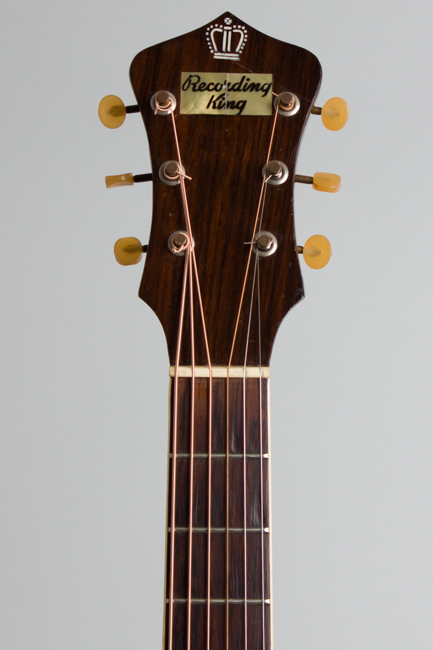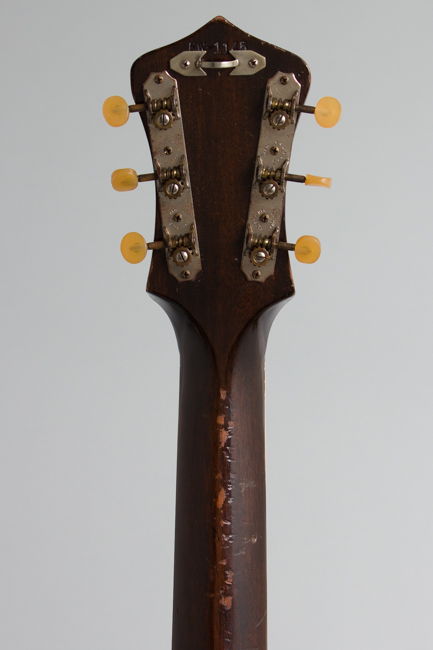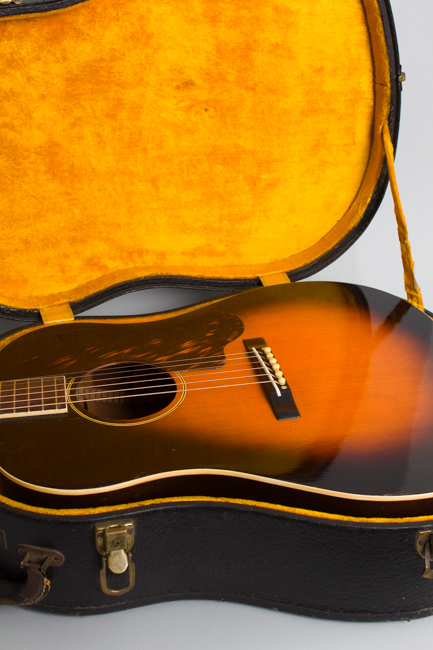Recording King Ray Whitley Jumbo Model 1028 Flat Top Acoustic Guitar, made by Gibson (1939)
This item is currently on hold.
Item # 12471
Prices subject to change without notice.
Recording King Ray Whitley Jumbo Model 1028 Model Flat Top Acoustic Guitar, made by Gibson (1939), made in Kalamazoo, Michigan, serial # EW-1145, sunburst top, dark back and sides finish, mahogany back, sides and neck; spruce top, rosewood fingerboard, black hard shell case.
This slope-shoulder Jumbo guitar is one of the rarer of Gibson's custom brand instruments, made exclusively for Montgomery Wards and endorsed by Singing Cowboy (and sometime Gibson consultant) Ray Whitley. These models were only available in the Ward's catalogs during 1939-40, listed at the amazingly low price of $19.95 (cash, or $3 a month on layaway) for this mahogany-body Model 1028 and $10 more its upscale rosewood-bodied sister, the Model 1027. The nearest equivalent to this model in Gibson's line is the equally rare J-55, the company's highest grade 16" Jumbo flat-top in 1940-41 which was priced at over $60.
This guitar has the same general look and feel as the J-55, including the special large "cowboy" pickguard covering the soundhole rings to better protect from hard strumming. Overall this is fairly deluxe guitar, especially for the price! The top is finished in a rich orangey sunburst, single bound with a 3-ply soundhole ring. The rosewood bridge is a simple rectangle common to many Gibson flat tops, with pearl dots covering the securing bolts. The mahogany back and sides are finished in natural, with single-ply back binding.
While most of Gibson's contract-brand flat-tops were built with heavier ladder-braced tops, this model has an Adirondack spruce top with a standard Gibson Jumbo X-brace pattern. Internally it is not finished out as neatly as a Gibson-brand equivalent; the braces are not shaped as delicately or as finely smoothed, but functionally it is crafted as well as its full-line equivalents.
The major concession to this guitar's off-brand status is the neck, one piece mahogany but lacking the Gibson adjustable truss rod, although the neck is steel reinforced. The rosewood fingerboard is single-bound with pearl dot inlay. The headstock has a center-peak shape inlaid with a pearl block with decal overlay spelling out "Recording King" and a small crown stenciled at the peak. The tuners are strip Klusons with attractive translucent plastic buttons and a cord bracket is mounted on the back of the headstock (a tassel cord was included in the package).
These first 1028 models do not carry Ray Whitley's signature, but he was pictured along side them in the catalog. "Because he finds that the wider deeper body gives fuller tones, Ray Whitley endorses the Jumbo" it read. This is a very light and responsive guitar for a Jumbo, with a bright and punchy sound -- the perfect cowboy guitar, just as advertised!
Overall length is 41 1/4 in. (104.8 cm.), 16 1/8 in. (41 cm.) wide at lower bout, and 4 7/8 in. (12.4 cm.) in depth at side, taken at the end block. Scale length is 24 3/4 in. (629 mm.). Width of nut is 1 3/4 in. (44 mm.).
This guitar is generally very well-preserved for an instrument from the pre-WWII era; it is in structurally fine condition and there is only fairly light wear to the all-original finish overall. The top and back show some small dings, dents and scrapes, with hardly any of the common strumwear. The back of the neck has more notable wear, with some loss to the lacquer along the spine and a series of light but feelable capo dinks and dents.
The only crack repair is to a spruce grain split off top edge of pickguard, running to the bridge. This has been sealed with minimal touchup and a couple of small cleats added beneath. Apart from this the guitar remains crack free. The "Recording King" headstock stencil is almost completely intact -- it had often flaked off the pearl background over time. The original Gibson neck cord mounting hardware are still present, but a modern strap button was added to the heel. The neck has been neatly reset and the original frets show just light wear in the lower positions. This is a lovely example overall; playability is excellent and the guitar offers a powerful bright but chunky sound. It resides in a nice 1960s era Gibson HSC. Overall Excellent Condition.
This slope-shoulder Jumbo guitar is one of the rarer of Gibson's custom brand instruments, made exclusively for Montgomery Wards and endorsed by Singing Cowboy (and sometime Gibson consultant) Ray Whitley. These models were only available in the Ward's catalogs during 1939-40, listed at the amazingly low price of $19.95 (cash, or $3 a month on layaway) for this mahogany-body Model 1028 and $10 more its upscale rosewood-bodied sister, the Model 1027. The nearest equivalent to this model in Gibson's line is the equally rare J-55, the company's highest grade 16" Jumbo flat-top in 1940-41 which was priced at over $60.
This guitar has the same general look and feel as the J-55, including the special large "cowboy" pickguard covering the soundhole rings to better protect from hard strumming. Overall this is fairly deluxe guitar, especially for the price! The top is finished in a rich orangey sunburst, single bound with a 3-ply soundhole ring. The rosewood bridge is a simple rectangle common to many Gibson flat tops, with pearl dots covering the securing bolts. The mahogany back and sides are finished in natural, with single-ply back binding.
While most of Gibson's contract-brand flat-tops were built with heavier ladder-braced tops, this model has an Adirondack spruce top with a standard Gibson Jumbo X-brace pattern. Internally it is not finished out as neatly as a Gibson-brand equivalent; the braces are not shaped as delicately or as finely smoothed, but functionally it is crafted as well as its full-line equivalents.
The major concession to this guitar's off-brand status is the neck, one piece mahogany but lacking the Gibson adjustable truss rod, although the neck is steel reinforced. The rosewood fingerboard is single-bound with pearl dot inlay. The headstock has a center-peak shape inlaid with a pearl block with decal overlay spelling out "Recording King" and a small crown stenciled at the peak. The tuners are strip Klusons with attractive translucent plastic buttons and a cord bracket is mounted on the back of the headstock (a tassel cord was included in the package).
These first 1028 models do not carry Ray Whitley's signature, but he was pictured along side them in the catalog. "Because he finds that the wider deeper body gives fuller tones, Ray Whitley endorses the Jumbo" it read. This is a very light and responsive guitar for a Jumbo, with a bright and punchy sound -- the perfect cowboy guitar, just as advertised!
Overall length is 41 1/4 in. (104.8 cm.), 16 1/8 in. (41 cm.) wide at lower bout, and 4 7/8 in. (12.4 cm.) in depth at side, taken at the end block. Scale length is 24 3/4 in. (629 mm.). Width of nut is 1 3/4 in. (44 mm.).
This guitar is generally very well-preserved for an instrument from the pre-WWII era; it is in structurally fine condition and there is only fairly light wear to the all-original finish overall. The top and back show some small dings, dents and scrapes, with hardly any of the common strumwear. The back of the neck has more notable wear, with some loss to the lacquer along the spine and a series of light but feelable capo dinks and dents.
The only crack repair is to a spruce grain split off top edge of pickguard, running to the bridge. This has been sealed with minimal touchup and a couple of small cleats added beneath. Apart from this the guitar remains crack free. The "Recording King" headstock stencil is almost completely intact -- it had often flaked off the pearl background over time. The original Gibson neck cord mounting hardware are still present, but a modern strap button was added to the heel. The neck has been neatly reset and the original frets show just light wear in the lower positions. This is a lovely example overall; playability is excellent and the guitar offers a powerful bright but chunky sound. It resides in a nice 1960s era Gibson HSC. Overall Excellent Condition.












